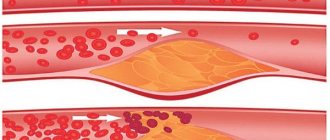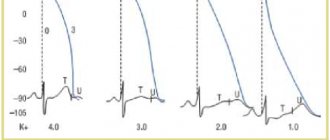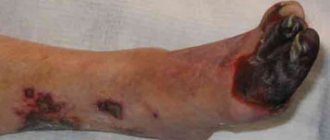What is stronger: atherosclerosis or cancer?
Atherosclerosis and its consequences for the cardiovascular system (thrombosis, heart attacks, strokes, kidney disorders, leg amputations) take more lives than all types of malignant tumors combined. According to various estimates, every second person dies from cardiovascular diseases, the main cause of which is atherosclerosis .
Atherosclerosis is a chronic inflammatory disease of the arteries that leads to the formation of plaque in the artery wall and narrowing of the lumen of the vessel. Subsequently, the inner surface of the artery is torn and platelets adhere to the narrowing area, a blood clot is formed, which leads to a stop in blood flow. This can cause acute cerebrovascular accident or myocardial infarction. With significant obliteration of the arteries of the legs, a typical symptom appears - intermittent claudication, which can result in amputation of the limb. Damage to the arteries of the kidneys is also very dangerous and causes hypertension.
However, atherosclerosis develops over many years, and in the early stages it can only be detected using special diagnostic methods, for example, vascular ultrasound. The early stages of atherosclerosis are characterized by visible thickening of the intima-media complex.
Intima, media, adventitia are the three components of the artery wall. With the development of atherosclerosis, the thickness of these two walls (intima and media) increases, which indicates inflammation and changes in the structure of the wall.
Heart attacks and strokes are acute circulatory disorders. But atherosclerosis first causes a chronic decrease in blood flow, and therefore the amount of oxygen to organs and cells. In this case, different symptoms may be observed, depending on the greatest localization of the process. For example, noise in the head or weakness in an upright position, leg cramps in a lying position. Symptoms may appear only at the 2nd or 3rd stage of atherosclerosis.
Surgical methods for treating obliterated vessels include stenting, bypass surgery, or mechanical removal of plaque from the vessel wall through an incision. The most common conservative approach is to lower cholesterol (cholesterol) levels in the blood using medications called statins.
A new treatment method is to restore the activity of the lymphatic system, because it is the system that is supposed to remove excess cholesterol from the artery wall.
Atherosclerosis of the coronary arteries
Atherosclerosis of the coronary arteries (which bring blood to the tissues of the heart) is one of the main causes of coronary heart disease and myocardial infarction: when the disease affects the vessels of the heart, heart muscle cells begin to die due to insufficient nutrition. And the risk of blood clot formation and vessel blockage only aggravates the situation. This condition is extremely dangerous, life-threatening and requires consultation with a doctor. You should pay special attention to possible symptoms:
- chest pain;
- feeling of heaviness, tightness in the chest;
- arrhythmia, i.e. fast or slow heartbeat;
- feeling of a sinking heart.
Do not underestimate the above symptoms. Let us remember that the risk of developing atherosclerosis is present in many people. Complications of the disease without proper treatment are so dangerous that you should consult a doctor, even if you are afraid of a confirmed diagnosis or surgery. Modern medicine has advanced far in the treatment of atherosclerosis of various localizations.
Cholesterol is not your enemy!
There are already many publications in foreign scientific literature about the role of the lymphatic system in the development of atherosclerosis (the formation of plaques in the arteries).
The lymphatic system is involved in the regulation of the immune response, inflammation and reverse cholesterol transport. Researchers show that what is responsible for the uncontrolled formation of plaque is not so much low-density lipoproteins, which everyone is up in arms against (from ordinary people and YouTube bloggers to nutritionists and even doctors), but rather the inability of the lymphatic system to remove the consequences of the attack on cholesterol by inflammatory cells.
“In other words, atherosclerosis is a problem of the immune system, the lymphatic system, and only then cholesterol,” explains Nadezhda Aleksandrovna Garyaeva, doctor of medical sciences, professor, lymphologist. Indeed, it makes sense to review the diet for hereditary hypercholesterolemia, but this does not mean that cholesterol itself is harmful.
High levels of total cholesterol and LDL in the blood are indeed a prognostic sign of the development of atherosclerosis. However, the disease does not develop due to cholesterol, but due to a decrease in the function of the lymphatic system against the background of the inflammatory reaction of the immune system to damage in the blood vessels, and cholesterol in this case is the target of attack by immune cells.
Cholesterol is an essential building material in the human body. It is used for the construction of cell membranes, the formation of sex hormones, and the secretion of bile acids. A large amount of cholesterol is contained in the myelin sheath of nerve fibers. Even in the process of Vitamin D synthase, one of the precursors is cholesterol. You can imagine the long-term consequences of artificially blocking cholesterol synthesis in the body. By the way, most of it is synthesized in the liver, and does not enter the body with food.
That is why the world is already discussing the ideas of pharmacological and even genetic correction of lymphangiogenesis - the process of formation of lymphatic vessels in the artery wall. A Russian clinic has developed and patented another approach - enhancing the function of the lymphatic system using lymphotropic injections of official (can be bought at the pharmacy) medications.
In modern medical education, the lymphatic system occupies an insignificant place, which is why in general medical practice you will never be offered what you will find in this article. Moreover, there are heads of universities who still believe that the lymphatic system is not worth any attention.
In this article, we were not only able to briefly and clearly summarize modern knowledge about atherosclerosis, but also revealed the approach of the Lymphatek Clinic to the pathogenetic (affects the mechanisms) treatment of atherosclerosis without the use of cholesterol-binding drugs (statins).
Symptoms of atherosclerosis of the extremities
The development of vascular pathology can be suspected based on the following symptoms:
- It is difficult or almost impossible to feel the pulse under the knee or in the groin.
- The patient feels pain along the back of the lower leg, which can rise up to the thigh. These sensations arise while walking, forcing you to stop, reducing the sections of one-time travel. After rest the pain goes away. Intermittent claudication develops.
- Acute pain in the foot.
- In young men, atherosclerosis of the lower extremities is accompanied by a decrease in potency.
During a visual examination of the patient's legs, making a diagnosis will not be difficult. The feet become cold to the touch, the skin becomes pale or bluish. If the disease is advanced, the skin acquires a marbled color; against the background of this “spotting,” areas of necrotic tissue damage often appear. Also an alarming sign is a decrease in hair on the legs and slow growth of nails.
What does the lymphatic system do?
The lymphatic system has been considered discovered since 1627 by the anatomist Gasparo Azelli, but Hippocrates first spoke about its individual parts in the 5th century. BC. It consists of lymphatic capillaries, vessels, nodes, lymphoid organs and covers each organ like the circulatory system.
The task of the lymphatic system is to drain and detoxify the pericellular space through the transport of interstitial fluid and the metabolic and breakdown products it contains, antigens and cytokines, immune cells and even lipoproteins.
The lymphatic system is actively involved in the body's immune response. It is in the lymphatic system that lymphocytes mature. It is the lymphatic system that absorbs fats from the small intestine that enter the body with food.
Since the beginning of the 19th century, data have been published that there are lymphatic capillaries in the walls of the artery, which cleanse it of metabolic products, but then no one was interested in this. Since the late 1980s, but especially active in the 2000s, with the active introduction of immunofluorescence imaging methods (markers such as LYVE-1, podoplanin, PROX1), research on the relationship between the lymphatic system and atherosclerosis has increased significantly, and everything has become to their places. Now no one doubts that the artery wall is indeed drained by the lymphatic network.
This means that the lymphatic network must also cleanse the wall of cholesterol plaque. In an experiment, this can be beautifully and demonstratively illustrated as follows. When lymphatic drainage is blocked in an experimental animal, atherosclerosis quickly begins to progress.
It was knowledge about the lymphatic system and its relationship with atherogenesis that formed the basis of our treatment technology.
Diet for atherosclerosis
If lipid metabolism is disturbed, it is necessary to saturate the menu with vegetables, fruits, and bran, which help cleanse blood vessels. The diet must include foods that have an anti-sclerotic effect:
- oranges or tangerines;
- apples;
- tomatoes;
- beet;
- salad;
- cucumbers;
- rhubarb;
- garlic;
- fenugreek.
According to the chemical composition, food should be distributed as follows: 100 g of proteins, 80 g of fats (30% of which are vegetable), 400 g of carbohydrates (of which only 40 g are fast).
The maximum calorie content of the daily diet should not exceed 2500 kcal. If the patient is overweight, this volume is limited to 1800 kcal. The amount of salt is reduced to 3 g per day. Among the cooking methods, preference is given to boiling, stewing, and baking.
How do plaques form?
Atherosclerosis is a systemic multifactorial disease. The initial etiological causes of atherosclerosis are laid long before the formation of plaques visible on ultrasound or MSCT in the walls of blood vessels. Later, the mechanisms of damage to the vessel wall, the formation of foam cells, the formation of plaque and calcifications in it directly join the causal background.
The process of development of atherosclerosis can be simplified into six stages:
- First, under the influence of various behavioral factors, an unfavorable genetic background is realized: homo- or heterozygous changes in genes. Genetic variations can manifest themselves in the form of changes in the structure and function of the cardiovascular system, lack of production of any substances for an adequate immune response and metabolism.
- Damage occurs to the endothelium (the layer of cells that covers the inside of the artery) due to arterial hypertension, chronic viral load, diabetes, smoking and other factors. Several mechanisms are involved: metabolism, neuroendocrine regulation, glucorticoid activity, immune response and autoimmune mechanisms.
- During inflammation, under the influence of white cells: neutrophils, macrophages and lymphocytes, additional loose connective tissue is formed in the inner wall of the vessel (intima) to compensate for the damaged area of the endothelium. It turns out to be tropic to cholesterol molecules and foam cells, that is, it simply attracts components from which a plaque is then formed.
- Low-density lipoproteins (LDL) come into the picture next. They are often simply called bad cholesterol. When penetrating the endothelium, deeper into the intima of the artery, LDL is oxidized and captured by a macrophage - one of the immune cells - and a so-called foam cell is formed. But for some reason (probably due to the same genetic defect), the phagocytic activity of immune cells is reduced, and the physiological lysis of this cell is disrupted and does not complete. Normally, unnecessary substances should break down into water and carbon dioxide. But this doesn't happen. As a result, the foam cell or its decay products are retained in the intimal structure.
- Normally, excess cholesterol and cell breakdown products from the artery wall should be drained by the lymphatic system. In the adventitia of the artery there are lymphatic capillaries that drain the wall, and excess protein, and everything unnecessary in the wall exits into the lymphatic channel and is sent through the lymphatic vessels to the lymph nodes. The problem is that the activity of the lymphatic system is reduced, and the lymphatic system cannot cope with the timely removal of plaque from the artery wall. This could be, for example, due to bacterial or viral infection of the lymph nodes.
- Now comes the interesting part, and it has to do with immunity. Once macrophages detect a potential enemy, LDL, they release chemicals that attract even more immune cells to the artery wall. As a result, even more foam cells are formed and the plaque continues to grow.
Thus, it is important to understand that atherosclerosis is an autoimmune disease that perpetuates itself.
Firstly, there is a proliferation of connective tissue, which the immune system perceives as foreign and, therefore, enhances the immune response.
Secondly, with the development of the atherosclerotic process, the body triggers a protective reaction, and the lymphatic network in the adventitia of the artery begins to grow. This is necessary so that excess amounts of breakdown products and lipoprotein are removed through the lymphatic system. However, this process also has a downside. More extensive lymphatic drainage increases the traffic of immune cells to the lymph nodes, thereby further increasing the immune response and therefore inflammation.
Thus, the process of atherogenesis cycles, and the disease progresses. Even if you sharply reduce the amount of cholesterol in the blood, this can negatively affect your health, but it will not affect atherosclerosis at all. As a result, the process of atherosclerosis reaches the borderline stage, when surgical treatment is already recommended, despite taking statins.
Which doctor should I contact?
Atherosclerosis of the lower extremities is a common disease, since the factors causing it are present in the lives of many people. Poor diet, smoking, etc. - these are the scourges of our time, which make disabled people out of young people by the age of 40.
Cardiologists and phlebologists treat ischemic diseases. If we are talking about the need for surgical intervention, vascular surgery can be performed by an angiosurgeon. In any case, contacting specialized specialists is the first step towards health and preventing the risk of disability or death from atherosclerosis of the lower extremities.
Make an appointment with a specialist, without queues, at a convenient time
+7
Sign up
Four components of the treatment of atherosclerosis
So, a patient with an active atherosclerotic process comes to the doctor. What to do? The main task is to stop the formation of plaque and start the reverse process. Obviously, the genetic background cannot be corrected, just like the damaged endothelium. We also found that cholesterol itself is not the starting point of the disease. We have shown that atherosclerosis actively develops due to immune inflammation, which maintains itself.
Thus, to stop atherosclerosis and reduce the size of the plaque, you need to launch a compensatory mechanism - the lymphatic system. To do this, the clinician’s focus should be on neutralizing the general inflammatory background, “balancing” local immune reactions and, most importantly, enhancing the activity of the lymphatic system to improve the drainage of “plaque” cells. At the same time, the patient must gradually make changes to his behavior pattern and, of course, start with diet.
The diet should be aimed not so much at reducing cholesterol, but at improving general metabolic processes and reducing the amount of foods that cause specific inflammation.
In other words, to remove plaque from the artery wall, you need to reduce the number of activated macrophages and speed up the removal of foam cells.
So here's what to do:
- Reduce the number of factors that provoke inflammation inside the artery wall
- Carry out drug correction of immunity based on an immunogram with stress tests
- Perform lymphotropic therapy to improve the functions of the lymphatic system in the area affected by atherosclerosis
- Perform infusion drug therapy to normalize metabolic processes in tissues and artery walls
On double target
The above-mentioned new class of anti-sclerotic drugs acting at the gene level includes substances that activate the so-called PPARs - special cellular receptor proteins. PPARs are transcription factors
: they “turn on” the work of certain genes, stimulating the production of corresponding proteins involved in the regulation of the most important physiological processes, including lipoprotein metabolism.
There are three forms of these receptor proteins - α, β and γ, and each of them is activated by its own specific compound ( agonist
) – for example, fatty acids or prostaglandins involved in the anti-inflammatory response. Each form regulates different, although overlapping, cascades of biochemical processes. For example, PPARα “activators” affect lipoprotein metabolism and are used to treat lipid metabolic disorders; PPARγ activators involved in glucose metabolism – for the treatment of type 2 diabetes.
It has long been known that patients with atherosclerosis often develop diabetes and have problems with lipid and carbohydrate metabolism in general. Therefore, recently there has been great interest in the creation of drugs based on double (α and γ) glycazars - tezaglitazar, ragaglitazar
) and even triple agonists of these receptors.
Research has shown that even small changes in the chemical structure of PPAR agonist compounds dramatically affect their ability to selectively bind to the target, which means that the pharmacological properties of such substances can vary greatly - because in this way we interfere with very subtle processes of metabolic regulation.
In general, this class of anti-atherosclerotic substances looks very promising, since they work in significantly lower doses than statins: after all, significantly fewer molecules are required to send a signal through relatively few receptors than to inhibit a large number of enzyme molecules. Hence the significantly lower toxic load on the body: tens to hundreds of times less than for statins, and thousands of times less than for conventional hypoglycemic drugs.
How is the treatment carried out?
The basis of treatment is infusion and injection drug therapy. Treatment is carried out in courses of 10-15 treatment visits with a break of 3-4 months. The total number of courses varies from 1 to 6, depending on the stage of the process and other individual characteristics. In some places the plaques go away completely and immediately, in others it takes time.
The treatment is carried out on an outpatient basis and is structured in such a way that the main result is achieved during the break between courses: we start the work of the lymphatic system, reduce inflammation - and the lymphatic system continues to work even when no medicine is administered.
The number of procedures and duration of required courses depends on the stage of the process and the presence of concomitant diseases. In cases of advanced atherosclerosis with almost complete obliteration of blood flow, for example, in the limbs, and when the task is to save the limb from amputation, we can recommend treatment up to 2 times a day at the first stage.
If there is significant damage to the heart vessels, but in the absence of direct indications for bypass or stenting, increased requirements are imposed on the patient’s compliance with the medical and protective regime.
Diagnostic monitoring of the condition of the arteries of the legs and neck is carried out using an ultrasound machine; monitoring of the condition of the heart vessels is carried out using multislice computed tomography.
Atherosclerosis: causes of the disease
There are 3 groups of factors influencing the development of the disease:
- irremovable;
- removable;
- potentially removable.
The first include the patient's gender, age and heredity. The risk of atherosclerosis increases in people after 40-50 years of age. In men, this process begins earlier, although by the age of 55 the number of cases among both sexes is the same, which is explained by a decrease in estrogen production in women. Atherosclerosis is more often diagnosed in patients whose relatives also suffered from this disease.
Removable factors include factors that a person himself can remove from life (smoking, sedentary lifestyle, poor diet). When smoking, nicotine tars negatively affect the condition of blood vessels. Atherosclerosis develops faster if a person eats a lot of fatty foods. With physical inactivity, metabolic and blood flow disorders also occur.
Potentially remediable diseases include changes in fat metabolism, hypertension, infectious diseases and intoxication. If you exclude these factors, you can slow down the development of pathology and prevent its consequences.
Treatment results
Depending on the initial localization of the process, already during the first course of treatment, the patient clinically notices the following improvements:
- Reducing noise in the head and headaches
- No pain when walking
- Disappearance of discomfort in the heart area during physical activity
The proposed treatment method is not generally accepted because it goes against the standards of the pharmaceutical industry. Currently, in general practice, the problem of atherosclerosis is dealt with therapeutically by cardiologists, and, if immediate surgical intervention is necessary, by vascular surgeons.
In addition, the treatment method requires in-depth knowledge of the morphology and physiology of the lymphatic system. Here, using the example of the treatment of lymphedema, we have already discussed why doctors in ordinary hospitals do not treat lymphedema.
Despite the fact that the first patient was treated 13 years ago (he managed to save his legs due to obliterating atherosclerosis of the vessels in the knee area), we still continue to accumulate statistical data and take a limited number of people for treatment. It is possible to come for treatment from another city. Treatment technologies are patented in the Russian Federation and can only be safely used at the Lymphatek Clinic. We select patients for whom treatment is indicated individually based on their application.
LEARN ABOUT TREATMENT POSSIBILITIES
You can learn more about the treatment process and some of the results in other blog articles. There are interesting videos with patient reviews and comments from leading doctors.
- Vascular atherosclerosis. Lymphologist's explanation.
- Atherosclerosis of leg vessels. Case of Yuri's treatment
- Atherosclerosis of the vessels of the neck and heart. Analysis of Valery's treatment.
Forecast and prevention of atherosclerosis
The prognosis for a person with atherosclerosis is mixed. If he adheres to the doctor’s recommendations (diet, quitting smoking and alcohol, drug treatment), then the prognosis is favorable, and the growth of plaques can be slowed down. For patients who do not heed these recommendations, the picture is sadder: the risk of myocardial infarction and stroke increases significantly.
Basic preventive measures:
- less animal fats, more vegetable oils;
- sufficient amount of vitamins and microelements;
- to give up smoking;
- limiting alcohol consumption;
- physical activity, normalization of body weight;
- avoidance of emotional stress and worries.
Bibliography
When compiling this article, we deliberately simplify some of the material so that it is understandable for non-specialists. If you are a doctor, we will be happy to answer your questions. Write or call us to discuss details. To prepare this material, the following publications were used:
- Girard JP, Moussion C., Forster R. HEVs, lymphatics and homeostatic immune cell trafficking in lymph nodes. Nat. Rev. Immunol. 2012;12:762–773. doi: 10.1038/nri3298.
- Randolph GJ, Miller NE Lymphatic transport of high-density lipoproteins and chylomicrons. J. Clin. Investig. 2014;124:929–935. doi:10.1172/JCI71610.
- Aspelund A., Robciuc MR, Karaman S., Makinen T., Alitalo K. Lymphatic System in Cardiovascular Medicine. Circ. Res. 2016;118:515–530. doi: 10.1161/CIRCRESAHA.115.306544.
- Alitalo K., Tammela T., Petrova TV Lymphangiogenesis in development and human disease. Nature. 2005;438:946–953. doi: 10.1038/nature04480.
- Moore KJ, Sheedy FJ, Fisher EA Macrophages in atherosclerosis: A dynamic balance. Nat. Rev. Immunol. 2013;13:709–721. doi: 10.1038/nri3520.
- Rademakers T., van der Vorst EP, Daissormont IT, Otten JJ, Theodorou K., Theelen TL, Gijbels M., Anisimov A., Nurmi H., Lindeman JH, et al. Adventitial lymphatic capillary expansion impacts on plaque T cell accumulation in atherosclerosis. Sci. Rep. 2017;7:45263. doi: 10.1038/srep45263.
- Milasan A., Ledoux J., Martel C. Lymphatic network in atherosclerosis: The underestimated pathway. Future Sci. O.A. 2015;1:FSO61. doi: 10.4155/fso.15.61.
- Camare C., Pucelle M., Negre-Salvayre A., Salvayre R. Angiogenesis in the atherosclerotic plaque. Redox. Biol. 2017;12:18–34. doi: 10.1016/j.redox.2017.01.007.
- Randolph GJ Mechanisms that regulate macrophage burden in atherosclerosis. Circ. Res. 2014;114:1757–1771. doi: 10.1161/CIRCRESAHA.114.301174
- Johnson RA Lymphatics of blood vessels. Lymphology. 1969;2:44–56.
- Drozdz K., Janczak D., Dziegiel P., Podhorska M., Patrzalek D., Ziolkowski P., Andrzejak R., Szuba A. Adventitial lymphatics of internal carotid artery in healthy and atherosclerotic vessels. Folia Histochem. Cytobiol. 2008;46:433–436. doi: 10.2478/v10042-008-0083-7.
- Kutkut I., Meens MJ, McKee TA, Bochaton-Piallat ML, Kwak BR Lymphatic vessels: An emerging actor in atherosclerotic plaque development. Eur. J. Clin Investig. 2015;45:100–108. doi: 10.1111/eci.12372
- Xu X., Lin H., Lv H., Zhang M., Zhang Y. Adventitial lymphatic vessels—An important role in atherosclerosis. Med. Hypotheses. 2007;69:1238–1241. doi: 10.1016/j.mehy.2007.04.007.
- Martel C., Randolph GJ Atherosclerosis and transit of HDL through the lymphatic vasculature. Curr. Atheroscler. Rep. 2013;15:354. doi:10.1007/s11883-013-0354-4.
- Huang LH, Elvington A., Randolph GJ The role of the lymphatic system in cholesterol transport. Front. Pharmacol. 2015;6:182. doi: 10.3389/fphar.2015.00182.
- Csányi G, Singla B. Arterial Lymphatics in Atherosclerosis: Old Questions, New Insights, and Remaining Challenges. J Clin Med. 2019;8(4):495. Published 2021 Apr 11. doi:10.3390/jcm8040495
- Levin Yu.M. Fundamentals of therapeutic lymphology. - M.: Medicine, 1986. - 288 p., ill.
Diagnostics
To make an accurate diagnosis, the vascular doctor prescribes a complex of diverse examinations to the patient.
- Ultrasound with Doppler of the arteries of the lower and upper extremities to compare indicators in the arms and legs.
- Duplex ultrasound of the arteries of the lower extremities, which allows you to assess how much atherosclerosis has affected the vessels directly, whether there are aneurysms or other pathologies in the walls.
- Load tests (bike treadmill, treadmill running).
- Multislice CT.
- Angiography of the arteries of the pelvis and legs.
How is atherosclerosis diagnosed?
Carotid vessels (carotid arteries) are among the most dangerous places for the localization of sclerotic formations. However, modern diagnostic methods detect such problems quite easily.
The examination may include a partial or full complex:
- Test for endothelial dysfunction (atherosclerotic test) - indicates the presence and location of the disease. In addition, it carries information about the tendency to atherosclerosis and similar diseases.
- Biochemical blood test, which includes cholesterol and its fractions, that is, the full lipid spectrum.
- Transcranial Doppler method.
- Ultrasound of the brain.
- Angiography.
- Oscillographic EchoEG.
- An analysis of the reasons that resulted in this pathology is required. Correct treatment should include this diagnostic stage in order to get rid of the cause, and not the consequences of atherosclerosis.
- Clarification of the state of the brain and its parts, which may primarily suffer from a lack of blood supply.
To get a more detailed picture, your doctor may order the following tests:
- Duplex scanning with functional tests of the head and neck vessels
- MRI
- Reconstruction of cerebral vessels









